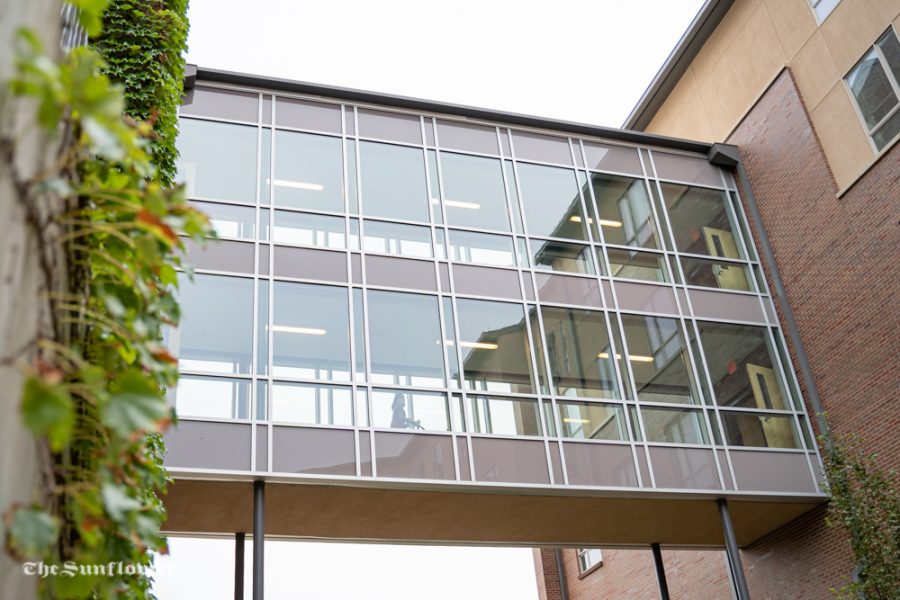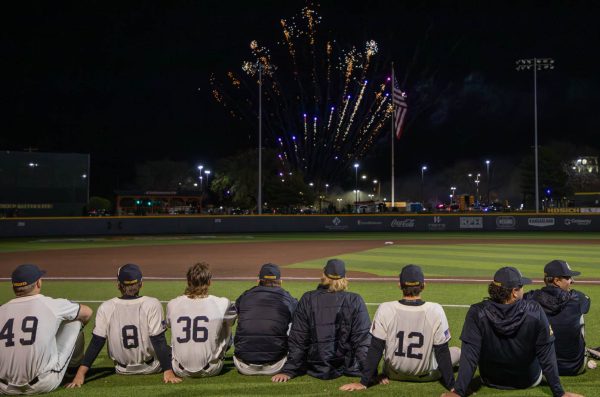OPINION: Shocker Hall door guards are cheap substitute for real security
This image shows a connecting hallway between the two buildings that comprise Shocker Hall. Residence halls will have extra safety steps this year.
Campus housing and residence life began locking all exterior doors except the front doors of The Suites, The Flats and the A1 and B0 doors in Shocker Hall after 10 p.m. This policy came into effect on January 14. These efforts are not only ineffective and inefficient, but avoid the root of the issue: once an individual is in the dorms, there is no stopping them.
One of the very first noticeable flaws of these precautions is the fact that they simply don’t work. Within the first several weeks, many of the doors could still be accessed after the late night hours and before the early morning hours. Stairwell doors were either locked as usual or remained locked during the day when they are supposed to be accessible.
As a woman on campus my first concern is that if I am being followed or pursued, there will be no refuge until I either activate a blue light — which still needs a few minutes for response time — or I can make it to an unlocked door that may be inaccessible.
Another issue is that the door guards can only keep watch from their enclosed posts just inside the building thresholds. Sure this can keep potential threats at bay, but it has little effect if they can still infiltrate the building via other unguarded doors. The guards have no means of knowing if there is danger on any floor aside from the one they are stationed at. What can solve this problem? Security cameras are an easy start.
Ceiling cameras in each hallway and block would be an easy way to monitor housing on-goings while being minimally invasive. A reliable electronic means of documenting the comings and goings of students and visitors is far more sound than the testimonial of an underpaid “security” guard, of which there are only two or three per building. Cameras can create time-verifiable records. If something were to ever happen, this type of security could lead to solid identifications and subsequent arrests.
The sad reality is that WSU prioritizes saving a few dollars over installing security cameras that will deter and record individuals with malicious intentions. While there have not been any recent reports of dormitory invasions or assaults, I fear it is only a matter of time before something tragic happens while guards unknowingly remain “watchful” at their posts.
Campus housing and residence life began locking all exterior doors except the front doors of The Suites, The Flats and the A1 and B0 doors in Shocker Hall after 10 p.m. This policy came into effect on January 14. These efforts are not only ineffective and inefficient, but avoid the root of the issue: once an individual is in the dorms, there is no stopping them.
One of the very first noticeable flaws of these precautions is the fact that they simply don’t work. Within the first several weeks, many of the doors could still be accessed after the late night hours and before the early morning hours. Stairwell doors were either locked as usual or remained locked during the day when they are supposed to be accessible.
As a woman on campus my first concern is that if I am being followed or pursued, there will be no refuge until I either activate a blue light — which still needs a few minutes for response time — or I can make it to an unlocked door that may be inaccessible.
Another issue is that the door guards can only keep watch from their enclosed posts just inside the building thresholds. Sure this can keep potential threats at bay, but it has little effect if they can still infiltrate the building via other unguarded doors. The guards have no means of knowing if there is danger on any floor aside from the one they are stationed at. What can solve this problem? Security cameras are an easy start.
Ceiling cameras in each hallway and block would be an easy way to monitor housing on-goings while being minimally invasive. A reliable electronic means of documenting the comings and goings of students and visitors is far more sound than the testimonial of an underpaid “security” guard, of which there are only two or three per building. Cameras can create time-verifiable records. If something were to ever happen, this type of security could lead to solid identifications and subsequent arrests.
The sad reality is that WSU prioritizes saving a few dollars over installing security cameras that will deter and record individuals with malicious intentions. While there have not been any recent reports of dormitory invasions or assaults, I fear it is only a matter of time before something tragic happens while guards unknowingly remain “watchful” at their posts.

Allison Campbell was the editor-in-chief of The Sunflower during the 2024-2025 year. Campbell is a senior pursuing a journalism and media production...










Mike Morgan • May 4, 2022 at 6:01 am
Do you need a quick long or short term Loan with a relatively low interest rate as low as 3%? We offer business Loan, personal Loan, home Loan, auto Loan, student Loan, debt consolidation Loan etc.. no matter your credit score.
Personal Loans (Secure and Unsecured)
Business Loans (Secure and Unsecured)
Consolidation Loan and many more.
Contact US for more information about Loan offer and we will solve your
financial problem. contact us via email: [email protected]
Phone number: +917428831341 (Call/What’s app)
LIZZY JOHNSON • May 2, 2022 at 2:21 pm
I bring you all the good news… it’s really a testimony for me…I never knew my partner was cheating on me until I came across an online Wizard who help me hack his phone got me access to it without any physical contact with his phone… I could access his chats text messages and all.. from there I know another woman got pregnant for him.. he even got the woman a house where he goes to sleep whenever he told me he’s on night duty… after that I confronted him.. he wanted to lie so I show him all the proof which he can not deny… big thanks to. WIZARD BRIXTON WIZARDBRIXTON AT GMAIL DOT COM though it wasn’t easy cause it’s heartbreak but I thank god I’m able to know and find out the truth. God bless America. God bless women out here … contact him for a HACKING JOB: WIZARDBRIXTON AT GMAIL DOT COM, WHAT-APP : (+) 1807234 0428
Dorothy Jean • Mar 25, 2022 at 8:42 am
Welcome to the future! Financing made easy with Prof. Mrs. DOROTHY JEAN INVESTMENTS
Hello, Have you been looking for financing options for your new business plans, Are you seeking for a loan to expand your existing business, Do you find yourself in a bit of trouble with unpaid bills and you don’t know which way to go or where to turn to? Have you been turned down by your banks? MRS. DOROTHY JEAN INVESTMENTS says YES when your banks say NO. Contact us as we offer financial services at a low and affordable interest rate of 2% for long and short term loans. Interested applicants should contact us for further loan acquisition procedures via Call/Text +1(863)226-6394 [email protected]
We invest in all profitable projects with cryptocurrencies. I’m here to share an amazing life changing opportunity with you. its called Bitcoin / Forex trading options, Are you interested in earning a consistent income through binary/forex trade? or crypto currency trading. An investment of $100 or $200 can get you a return of $2,840 in 7 days of trading and you get to do this from the comfort of your home/work. It goes on and on The higher the investment, the higher the profits. Your investment is safe and secured and payouts assured 100%. if you wish to know more about investing in Cryptocurrency and earn daily, weekly OR Monthly in trading on bitcoin or any cryptocurrency and want a successful trade without losing Contact MRS.DOROTHY JEAN INVESTMENTS Call/Text +1(863)226-6394 Email [email protected]
YOURS IN SERVICE
Mrs. Dorothy Pilkenton Jean
Financial Advisor on Bank Instruments,
Private Banking and Client Services
Email Address: [email protected]
Operation: We provide Financial Service Such As Bank Instrument
From AA Rate Banks, Cash Loan,BG,SBLC,BOND,PPP,MTN,TRADING,FUNDING MONETIZING etc.
Mrs. Dorothy Pilkenton Jean • Mar 25, 2022 at 8:41 am
Welcome to the future! Financing made easy with Prof. Mrs. DOROTHY JEAN INVESTMENTS
Hello, Have you been looking for financing options for your new business plans, Are you seeking for a loan to expand your existing business, Do you find yourself in a bit of trouble with unpaid bills and you don’t know which way to go or where to turn to? Have you been turned down by your banks? MRS. DOROTHY JEAN INVESTMENTS says YES when your banks say NO. Contact us as we offer financial services at a low and affordable interest rate of 2% for long and short term loans. Interested applicants should contact us for further loan acquisition procedures via Call/Text +1(863)226-6394 [email protected]
We invest in all profitable projects with cryptocurrencies. I’m here to share an amazing life changing opportunity with you. its called Bitcoin / Forex trading options, Are you interested in earning a consistent income through binary/forex trade? or crypto currency trading. An investment of $100 or $200 can get you a return of $2,840 in 7 days of trading and you get to do this from the comfort of your home/work. It goes on and on The higher the investment, the higher the profits. Your investment is safe and secured and payouts assured 100%. if you wish to know more about investing in Cryptocurrency and earn daily, weekly OR Monthly in trading on bitcoin or any cryptocurrency and want a successful trade without losing Contact MRS.DOROTHY JEAN INVESTMENTS Call/Text +1(863)226-6394 Email [email protected]
YOURS IN SERVICE
Mrs. Dorothy Pilkenton Jean
Financial Advisor on Bank Instruments,
Private Banking and Client Services
Email Address: [email protected]
Operation: We provide Financial Service Such As Bank Instrument
From AA Rate Banks, Cash Loan,BG,SBLC,BOND,PPP,MTN,TRADING,FUNDING MONETIZING etc.
JOANNA ANDERSEN • Mar 19, 2022 at 5:32 am
BEST WAYS TO GET YOUR EX LOVER BACK AND RESTORED YOUR BROKEN MARRIAGE OR RELATIONSHIP FROM SORROW TO HAPPINESS.
Help me thank DR LARRY for helping me get my ex husband back to me and my family. This great powerful spiritual man restored my sorrow to happiness. My husband left me some years ago for another woman and they both planned to get married. I am so surprised he just came back to me one cool afternoon on Saturday, begging and crying for me to take him back and to forgive him for breaking up our marriage home and forsaking me and the children. Dr Larry is a true spiritualist savior . He brought my husband back” if you have any worries or you have any problem in your marriages or relationships you can reach him via:
Email: [email protected]
Whatapp: +1(424)-261-8520
website http://assurancesolutioncenter.website2.me/
facebook page: https://www.facebook.com/assurancesolutionhome/ ,,,
firmwarehacks • Mar 12, 2022 at 7:37 pm
BINARY SCAM RECOVERY
❌ Binary Option, Forex and their likes are a means of making money but it’s more like gambling. There are no sure means to guarantee that a person could make profit with them and that’s why it can also be reasoned to be scam. Let’s not forget that some individuals even give you % guarantee of making profits and end up running away with your money. The internet today is full of Binary Option Recovery Scam, you see so much testimonies been shared about how a firm or Company helped them recover what they lost to Binary Options. But believe it, it’s just a way to lure more people and end up scamming them.
❌ You might have also come across some individuals that say they will give you guarantee on successful trades but they only end up as SCAMMERS as well. You here them say stuffs like 200% guaranteed in just 2 weeks and when you go into trade with them, they start telling you to pay profits percentage before you can get your income. These are all liars please avoid them. But if you have been a victim of this guys, then you should contact FIRMWARE now‼️
✳️The big Question is “Can someone Recover their money lost to Binary Option and Scam⁉️
I will say yes, and will tell you how.
The only way to Recovery your money back is by hiring HACKERS to help you break into the Firms Database Security System using the information you provide them with, Extract your file and get back your money. It seems like a really impossible thing to do, I will tell you, it should be impossible, but with the use of specially designed softwares known to HACKERS and Authorities (such as The FBI, CIA e.t.c) it is possible and the only way to recover your money.
✅FIRMWARE are a group of hackers who use their hacking skill to hunt down SCAMMERS and help individuals recovery their money from Internet SCAMMERS.
We just need the contact details of the SCAMMERS and Paymnet Info and within 4-8 hours your money will be return to you.
✳️ You can contact us via the emails below-:
[email protected]
We also provide Legit Hacking Services such as-:
Phone Hacking/Cloning
Email Hacking & Password Recovery
Social Media Hacking & Passowrd Recovery
Deleted Files Recovery Mobil Tracking
Virus detection & Elimination.
Email-: [email protected]
Firmware
2022 © All Right Reserved.